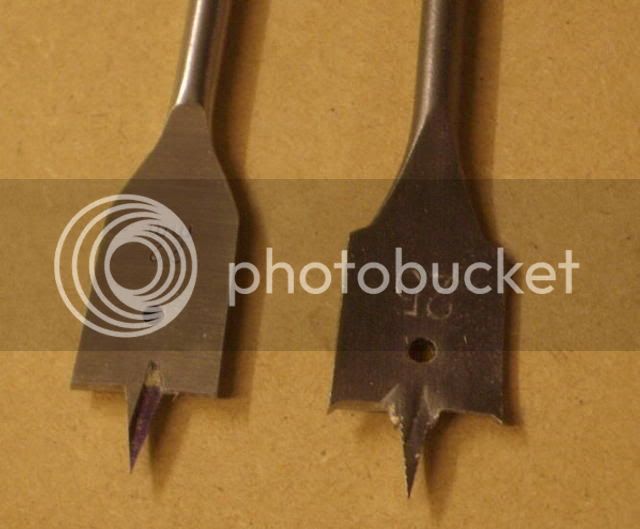WandrinAndy
Established Member
On a previous bench build, I drilled 108 dog-holes (19mmx62mm) in the MDF worktop of a bench partly based on an MFT (Multi-Function-Table). For holding 19mm Oak dowels, the diameter of these dog-holes is fine, although possibly a tad loose. I first drilled +-25mm with a 3/4" (19.05mm?) Forstner bit, and then drilled through with a 19mm Irwin Spade bit which has since grown legs and run.
However, I recently drilled about 40 dog-holes (19mmx50mm) in another worktop comprised of 18mm MDF and 32mm laminated chipboard, and have a wee problem... the diameter of the holes is a tad too narrow!!! These were drilled through in one go with a 19mm Irwin Power Auger bit.
The dowels are binding in the top MDF layer even before they reach the chipboard.
I am hoping somebody can please suggest an easy way to solve the too narrow dog-holes?
Stupidly I drilled all of the bench dog-holes before checking the resulting holes, as I had recently used the same Power Auger bit to drill 24 holes in 70x70 pine, when making a horizontal timber rack, and the 19mm Oak dowels fitted nice and tight in those holes. With hindsight maybe too tight for bench dog-holes, and I should have drilled the first 5-10mm with the Forstner bit!
Out of interest, a digital calliper measures our current three nominal 19mm bits as follows:
18.95mm = Irwin Power Auger bit, although it is somewhat difficult to measure this type of bit accurately
19.03mm = Forstner 3/4" bit
19.40mm = Spade bit from a cheapish combination bit set
By the way, for the layout I used a sheet of pegboard that was clamped to the worktop while all the dog-hole positions were centre-punched at 4 pegboard holes/inches apart. I used crayon to pre-mark the shiny white side of the pegboard to know where... and more importantly where not... to drill.
Key to me drilling the dog-holes straight was using what I call a drill-through "jig" that I built around a cheap drill-stand-press thingy, that I find works well for this purpose. I am sure others have better ideas for getting the holes straight....

And whereas I felt very much in control with the Forstner bit, and to a lesser extent with the Spade bit, I found that with the Power Auger bit I had to set the drill speed high enough to prevent it stalling, and once it bit (no pun intended) into the work piece, there was virtually no stopping it and the hole was done. I am guessing that this is because of the screw-thread-point?
Thanks,
Andy
However, I recently drilled about 40 dog-holes (19mmx50mm) in another worktop comprised of 18mm MDF and 32mm laminated chipboard, and have a wee problem... the diameter of the holes is a tad too narrow!!! These were drilled through in one go with a 19mm Irwin Power Auger bit.
The dowels are binding in the top MDF layer even before they reach the chipboard.
I am hoping somebody can please suggest an easy way to solve the too narrow dog-holes?
Stupidly I drilled all of the bench dog-holes before checking the resulting holes, as I had recently used the same Power Auger bit to drill 24 holes in 70x70 pine, when making a horizontal timber rack, and the 19mm Oak dowels fitted nice and tight in those holes. With hindsight maybe too tight for bench dog-holes, and I should have drilled the first 5-10mm with the Forstner bit!
Out of interest, a digital calliper measures our current three nominal 19mm bits as follows:
18.95mm = Irwin Power Auger bit, although it is somewhat difficult to measure this type of bit accurately
19.03mm = Forstner 3/4" bit
19.40mm = Spade bit from a cheapish combination bit set
By the way, for the layout I used a sheet of pegboard that was clamped to the worktop while all the dog-hole positions were centre-punched at 4 pegboard holes/inches apart. I used crayon to pre-mark the shiny white side of the pegboard to know where... and more importantly where not... to drill.
Key to me drilling the dog-holes straight was using what I call a drill-through "jig" that I built around a cheap drill-stand-press thingy, that I find works well for this purpose. I am sure others have better ideas for getting the holes straight....

And whereas I felt very much in control with the Forstner bit, and to a lesser extent with the Spade bit, I found that with the Power Auger bit I had to set the drill speed high enough to prevent it stalling, and once it bit (no pun intended) into the work piece, there was virtually no stopping it and the hole was done. I am guessing that this is because of the screw-thread-point?
Thanks,
Andy



































